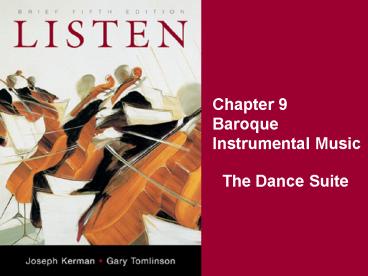Chapter 9 Baroque Instrumental Music PowerPoint PPT Presentation
1 / 16
Title: Chapter 9 Baroque Instrumental Music
1
Chapter 9Baroque Instrumental Music
- The Dance Suite
2
Key Terms
- Suite
- Baroque dance form
- Binary form
- Trio
- French overture
- Air
- Walking bass
- Inversion
- Allemande
- Courante
- Sarabande
- Minuet
- Gavotte
- Bourrée
- Siciliana
- Gigue
3
The Dance Suite
- Dance music popular in Baroque era
- Customary to group dances in a suite
- All in same key fast dance at the end
- Composed dances usually stylized
- Written for listening, not dancing
- Retain many features of music for dancing
- Allow greater musical sophistication
- Written for various performing forces
- Orchestra, chamber ensembles, or solo harpsichord
or lute
4
Baroque Dances
- Many different Baroque dances
- Distinguished from each other by
- Specific dance steps
- A certain meter
- A distinctive tempo
- Unique rhythmic features (e.g., two-beat upbeat
for gavotte) - Most dances use Baroque dance form
- Also called binary form
5
Baroque Dance Types
- Allemande 4/4 moderate flowing motion
- Courante 3/2 moderate uses 6/4 at times
- Sarabande 3/4 slow often accents beat 2
- Minuet 3/4 moderate straight rhythm
- Gavotte 4/4 moderate double upbeat
- Bourrée 2/2 rather fast short upbeat
- Siciliana 12/8 moderate gently rocking
- Gigue 6/8 fast short upbeat, lively
6
Baroque Dance Form
- Most Baroque dances use binary form
- Two sections a b
- Each section ends with strong cadence
- Each section is repeated
- Symmetrical feela b sections often share same
motives, cadences, other features - b section usually longer than a
- Form can be diagrammed as
- a a b b or abbreviated as a b
7
Dance and Trio (1)
- To create larger-scale dance works
- Composers grouped dances in suites
- Sometimes they grouped two dances of the same
type e.g., two minuets or two gavottes - Second dance of each pair called a trio
- Minuet Trio or Gavotte Trio
- Trio often scored for three instruments
- First dance returns again at the end
- Overall ternary form A B A
8
Dance and Trio (2)
- Based on principles of contrast return
- Trio uses different melody rhythms, softer
dynamics, lighter scoring - Return of 1st dance creates satisfying conclusion
- Form can be diagrammed as
9
The French Overture (1)
- Some suites begin with French overture
- Originally used by Louis XIVs orchestra
- The 24 Violins of the King
- Later used to begin many works
- Operas, suites, sonatas, oratorios (Messiah)
- Uses binary form, but with more contrasts than
usual
10
The French Overture (2)
- A section slow tempo, sharply dotted rhythms,
duple meter, homophonic texture - B section fast tempo, often compound meter,
imitative polyphony
11
Bach, Orchestral Suite No. 3 in D
- Likely written for student orchestra at
University of Leipzig - Scored for festive Baroque orchestra
- Strings, 2 oboes, 3 trumpets, 2 timpani,
continuo - Includes several dance types
- French overture, air, gavotte trio, bourrée,
gigue - Most are examples of Baroque dance form
12
Bach, Air (1)
- French air aria (song)
- Bachs most famous, beloved melody
- Scored for strings continuo
- Uses Baroque dance (binary) form
- Spontaneous, singing melody uses irregular
rhythms - Rising sequences build intensity in b section
- Melody supported by stable walking bass
13
Bach, Air (2)
14
Bach, Gavotte (1)
- Scored for festive Baroque orchestra
- Trumpets create march-like feel
- Typical gavotte two-quarter-note upbeat
- Uses gavotte trio format
- Both dances use Baroque dance form
- Trio typical in providing contrast with Gavotte
unusual in its use of full orchestra - 1st gavotte returns at the end
15
Bach, Gavotte (2)
- Example of inversion in b section of Gavotte (a
learned device)
16
Conclusions
- Contrasting dances were often grouped in
large-scale works called suites - Dances were typically in binary form
- Two short, subtly contrasted, sections that
repeat - Greater length contrast achieved by pairing
like dances (e.g., gavotte trio) - Stylized or not, dances relied on
- Clear melodies, simple textures, strong rhythms

